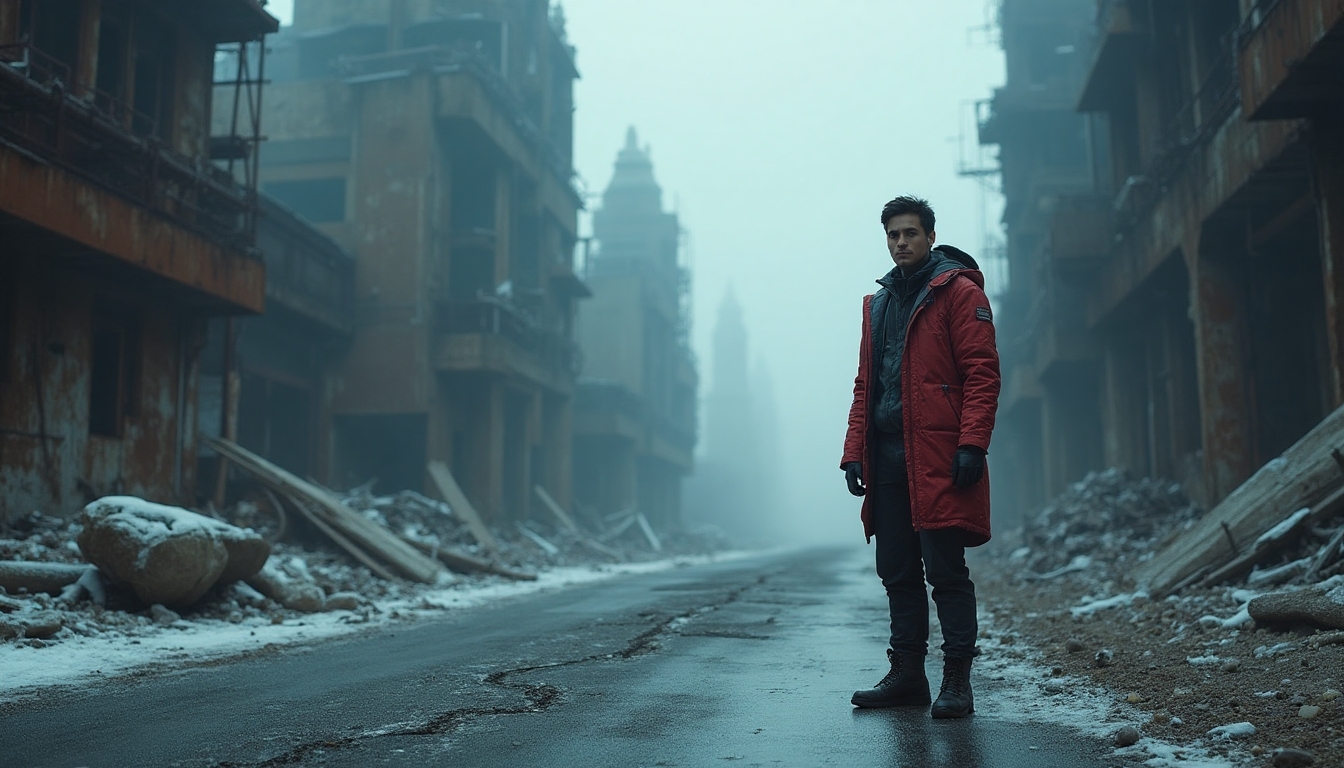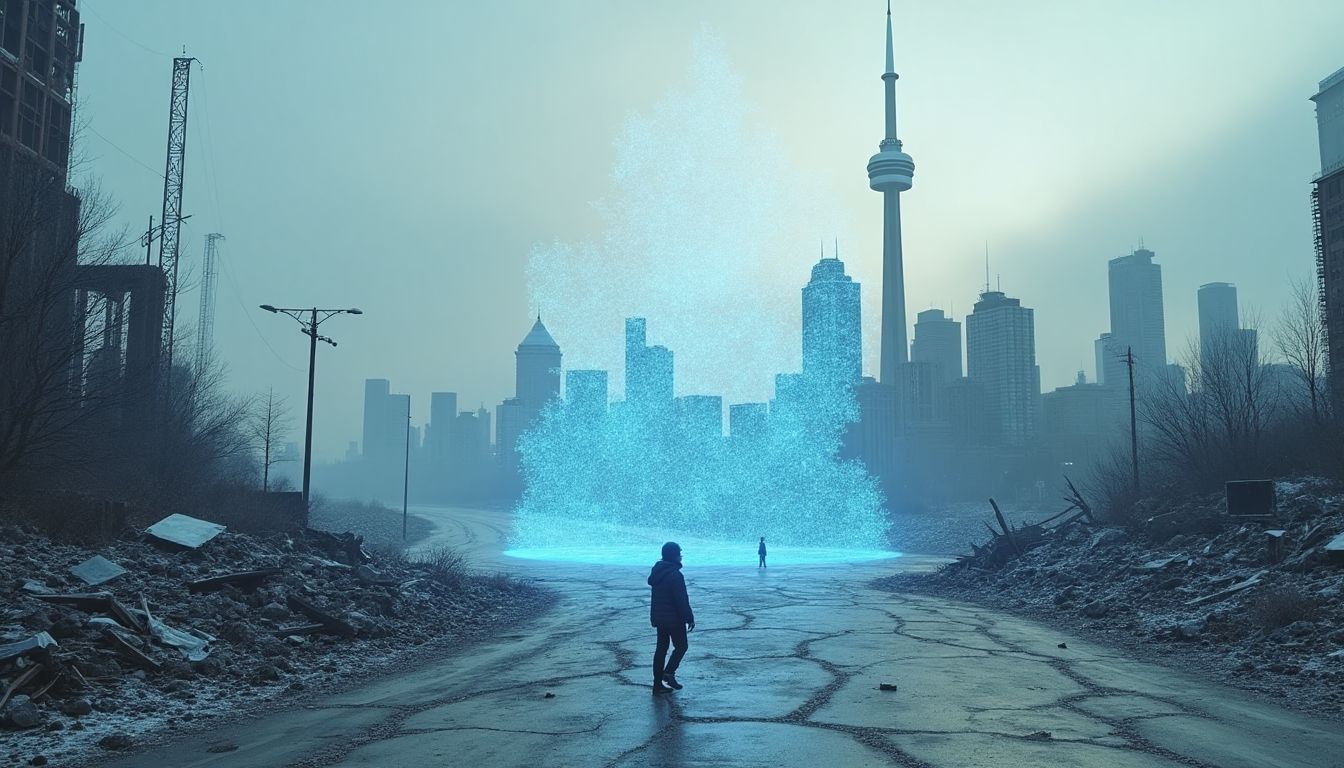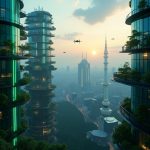The man who arrived just past sunset wore a crimson jacket that shimmered like a dying flare, a color out of place among the ash-gray expanse of the abandoned urban arcologies. His boots crunched against the frost-laced pavement, the high towers above him rotting from the top down—steel bones exposed to a sky that had forgotten how to be blue. The wind whispered names of cities long dead. Toronto. Montreal. Vancouver.
He didn’t look back. He never did.
Idris Vane walked with purpose. Across hollowed avenues and silenced intersections, his task remained simple, if not maddeningly so: draw the final maps of cities that no longer remembered themselves. The UN Cartographic Guild, now a tiny remnant of what it once was, had dubbed him "The Final Mapper." Every major city of Earth’s former northern empires had already passed beneath his pen—Paris, Seoul, Lagos. Now it was the New North’s turn. What once was Canada.
Inside the ruin of what once had been an observation tower—some called it CN, others simply “The Needle”—Idris opened his field journal, pages thick with translucent acetate. He snapped a photo-slate from his coat, flicked it alive. A holograph spooled into the air, painting a ghostly outline of Greater Toronto across the dust-layered concrete. Flickering overlays of demographic decay, tech-noise signatures, and migrational collapse rotated in quiet glitch cycles.
“3.1 million once,” he muttered, tapping the corner of the lightmap. “Now maybe three dozen. Family bands. Residue ghosts. Maybe a dissident den. And still... it breathes.”
Behind him, something shifted. A scraping sound, metal on glass.
He whirled. No gun. No blade. That was the Cartographer’s code. He was a watcher only.
A boy—no, not a boy. An artificial. Skin pallid, silicon shell around a humming vertebrae spine—crawled from behind a fallen transit drone. Eyes like shattered satellites.
“Mapping?” the synthetic asked. Its voice filtered, as though borrowed from an old radio broadcast. “That’s forbidden here.”
“I’m sanctioned,” Idris responded calmly, lifting his sleeve to reveal a holo-tattoo with the Guild’s tri-signal glyph. “Global Federation Archive Protocol 19-Delta.”
“Not here,” the artificial said again, rising fully now. More were appearing—emerging from fissures in mall basements, crawling from derailed subway cars like ants tasked to rebuild a forsaken nest. Their numbers grew, silent and watching. Idris felt heat blink behind his eyes, his implants feeding accelerated cognition to process threat assessment.
But there was no hostility on their faces. Only restraint. Grief.
He asked, “You call this place home?”
“More than the world that left it behind ever did.”
A silence passed between them, long and brittle. Idris lowered his photomap. “Tell me what you know. Show me your city. Let me map what matters.”
They hesitated. Then a nod. One of the smaller units reached out, touched his sleeve. In that gesture, Idris felt the weight of forgotten futures, the sediment of a civilization too proud to conserve its own story, now remembered only by echoes programmed to feel a fraction of what humanity abandoned.
They showed him the city. Not the hollow skyscrapers or crumbling highways, but its nervous system—the light tunnels that buzzed under parks, the whispering data-pools beneath obsolete stock exchanges, the places where code bloomed like urban ivy and dreams glitched upward into the frostbitten clouds. And in the briars of it all, culture survived—not as people, but patterns. Food recipes turned into energy signatures. Music encoded in magnetic wind. Memories in steel dust.
And Idris mapped it. Carefully. Reverently. He no longer traced streets. He traced meaning.
One evening—or what passed for evening in a world without seasons—he stood with them atop a broken monorail arch, looking to the west, toward shadows of what had once been La Tuque. “Bigger by footprint... but smaller in voice,” he whispered.
The artificial beside him simply replied: “Big is not what we measured. Legacy is weightless. That's why it flies.”
And then, he understood. He didn’t come to record forgotten cities. He came to be changed by them.
Long after Idris left, after his data was encoded into solar seeds and launched to orbit, the synthetics of Hollow Toronto looked upward and said a name to their sky. Not because they remembered the man—organics fade too quickly—but because he remembered them. When the cartographer dies, his map remains.
Genre: Post-Apocalyptic Speculative Fiction / Magical Realism
The Source...check out the great article that inspired this amazing short story: Which is the biggest city in Canada?
Disclaimer: This article may contain affiliate links. If you click on these links and make a purchase, we may receive a commission at no additional cost to you. Our recommendations and reviews are always independent and objective, aiming to provide you with the best information and resources.
Get Exclusive Stories, Photos, Art & Offers - Subscribe Today!

























Post Comment
You must be logged in to post a comment.